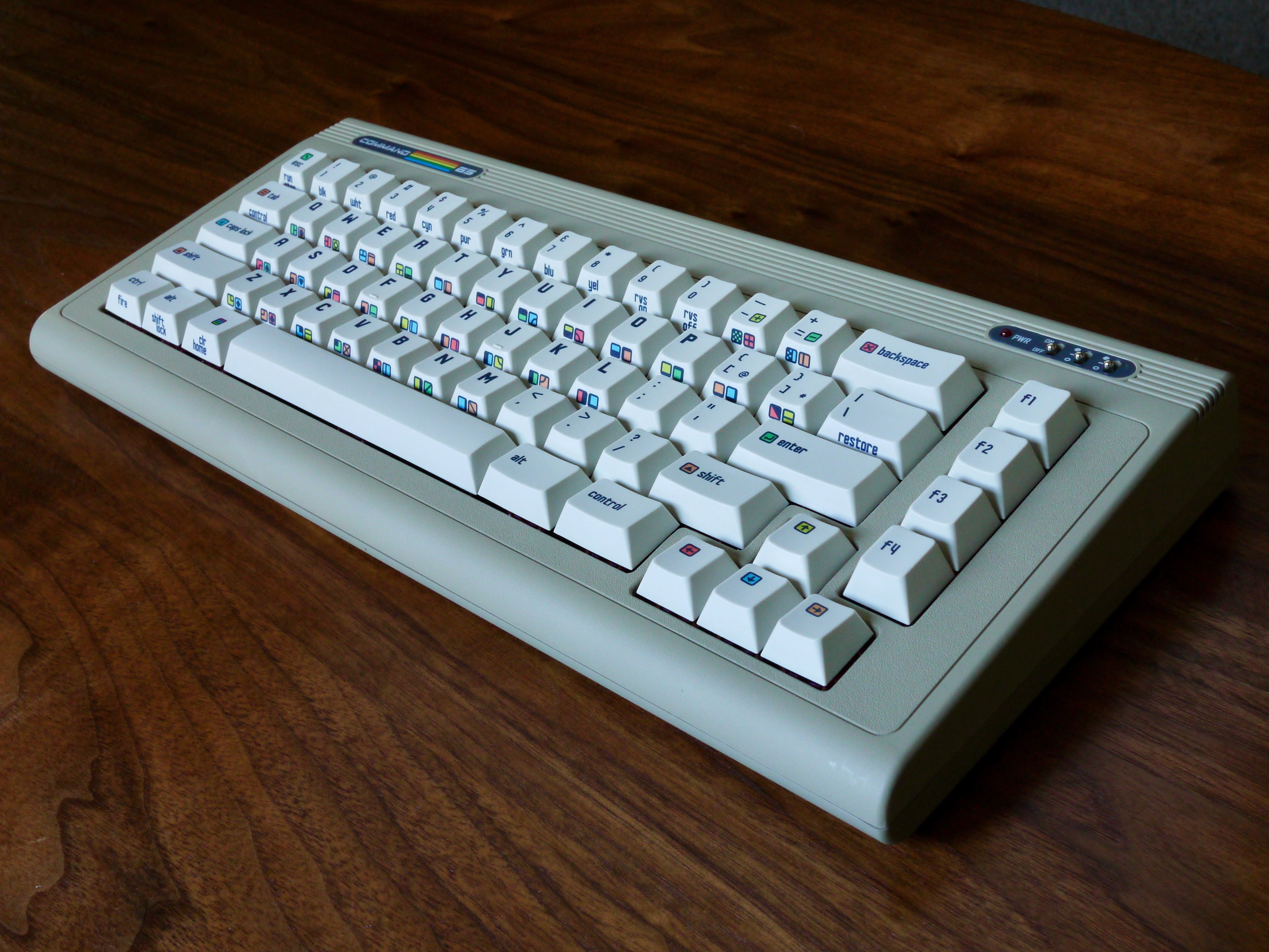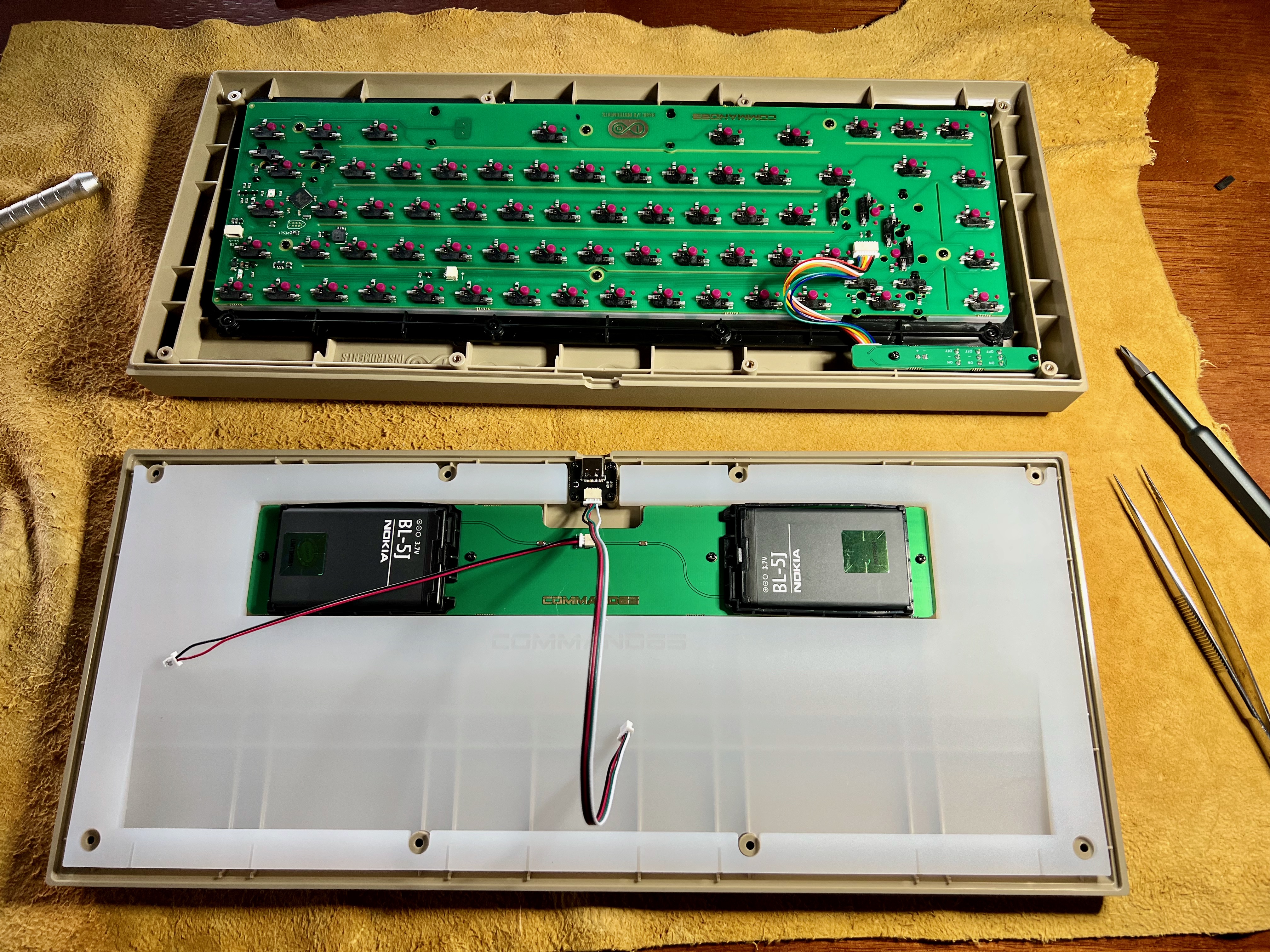Command 65 by Play Keyboard
keyboardsBuild details:
- Command 65 by Play Keyboard
- Ice Kachang Tactile Switches
- TX Stabilisers (PCB mount)
- Hammerworks CRP C64 Round 2 keycaps
This is the first in my series of posts about my keyboard collection; not because it’s my favourite, or because it’s the most expensive or the best, but because it’s really easy to photograph.

Depending on how you define ‘first’, my first computer was a Commodore 64.1 Yes, this keyboard was purely a nostalgia kick. But it’s also a pretty good keyboard.
The Command 65 is a bit of a weird duck. It supports QMK and Via, but also has a Bluetooth module and batteries (two Nokia-branded mobile phone batteries, in fact).2 I’ve never run it wirelessly, but given the size of the batteries it should last a while.

Building this was a challenge. Most of the interior void is filled with a great big piece of shaped silicone, which makes for a good sound profile, but which squishes the components together. Due to some poor tolerances in the components that held the PCB in place, the PCB would shift a little when you assembled the case, causing some of the keys (particularly in the arrow cluster) to rub against the case, potentially resulting in them catching.
Various solutions were discussed in the Play Keyboard Discord server about the issues, and the fix that worked for me was a bit of electrical tape on the top bracket (to increase the width of the bracked to push the PCB down a little) and a bit of trimming of the bottom bracket. Now it seems to be fine. This isn’t a particularly common problem with keyboards because most serious keyboards are milled out of metal, whereas the Command 65 is injection-moulded ABS plastic, which apparently isn’t quite as precise (but is more true to the spirit of the Commodore 64).
The keycaps are dye-subbed PBT, and aren’t quite what I remember from my C64 (I had the classic ‘breadbin’ style, which probably would have suited some SA-profile keycaps, but I couldn’t find any at the time that I really loved). And the front legends do also work, from a nostalgia perspective. The main problem with the keycaps is that they’re not Mac-friendly (as in they don’t have an equivalent to a Command key – I can’t believe this is still an issue with keycap sets in two-thousand-dickety-four).
Other fun facts about this keyboard include that it has a buzzer that sounds whenever you hit a key. This is fun for about five seconds, but luckily can be turned off (assign ‘Audio Toggle’ to a key in Via and use it to turn off the buzzer). It also has a bright red power LED which can’t be disabled through software (though you can unwire it). The two switches next to the power switch can be assigned like any other switch in Via (I have mine set to change layers).
The front edge of the keyboard is quite thick, mirroring the design of the Commodore 64 (how the hell did we ever type on those things). The first row of keys is about 25mm off the desk. Even by mechanical keyboard standards this is quite high, so you may need a wrist rest (or just a bit of practice) to type comfortably with it.
Also a quick shout-out to the Ice Kachang tactile switches (pre-lubed with 55g springs, POM stem, PC top housing and Nylon bottom housing). These switches are really nice in this board – they’re quite tactile and sound great, but how much of the sound is due to the switches and how much is the fact that they keyboard is stuffed with silicone I couldn’t say. They feel heavier than the advertised 55g to me, so if you’re not used to tactiles these might be a bit tiring to type on, but I have to say that I love the feel. For the price, they’re really good.
Overall, this is a quirky-arse keyboard and I kind of love it, but I wouldn’t make it my daily driver because it’s just a bit too weird in practice.
-
My dad was a computer technician in the 1970s and 1980s, so we always had computers around the house for as long as I can remember, but the Commodore 64 was in my bedroom and the one that actually did useful things. ↩︎
-
QMK and Bluetooth do not typically play well together, which is why most Bluetooth keyboards use ZMK, so I’m not sure exactly what is going on here. It was originally only configurable through Via, and QMK came a bit later. ↩︎